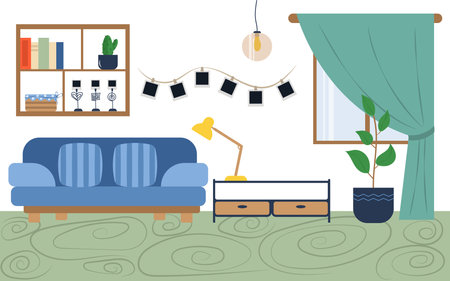A Glimpse into the British Colour Aesthetic
When we think of Britain, images of misty mornings, rolling green hills, and rows of terraced houses often come to mind. These quintessential features of the British landscape shape not only daily life but also the nation’s distinctive colour palette. Britain’s famously unpredictable weather casts a soft, diffused light across the country, muting even the brightest hues and lending an air of subtlety to its visual identity. The architecture, with its historic sandstone cottages, red-brick Victorian terraces, and grand Georgian facades, adds another layer to this aesthetic. Even in bustling cities like London or Manchester, splashes of deep navy, mossy green, and warm clay tones peek through the urban grey. The surrounding countryside is equally influential: wild heaths brushed with purple heather, stormy coastlines lined with slate-blue seas, and patchwork fields in every shade of green. Together, these elements create a palette that is at once understated and rich—steeped in history and shaped by nature. Understanding these influences offers a unique perspective on why certain colours resonate so deeply within British culture.
Royal Blues and Regal Reds: Heritage Hues
When it comes to colours that truly encapsulate the British spirit, few shades are as evocative as deep royal blue and vibrant red. These hues have long been woven into the fabric of national identity, especially through their associations with monarchy, military pageantry, and centuries-old traditions.
The Significance of Royal Blue
Royal blue is more than just a stylish choice—its a colour steeped in symbolism and ceremony. Historically, it became synonymous with British royalty after King George III commissioned a new shade for Queen Charlotte in the 18th century. Since then, royal blue has adorned everything from ceremonial uniforms to the iconic British passports.
Royal Blue at a Glance
| Context | Use of Royal Blue | Cultural Meaning |
|---|---|---|
| Monarchy | Ceremonial robes, state regalia | Nobility, dignity, continuity |
| Public Institutions | UK passports, police uniforms | Authority, trustworthiness |
| Everyday Life | School blazers, sports teams (e.g., Chelsea FC) | Pride, tradition |
The Power of Regal Red
Regal red stands equally tall in the pantheon of British hues. Its prominence can be traced back to Tudor times, when it was featured in heraldic symbols and royal standards. Today, this vibrant red is instantly recognisable on everything from the uniforms of the Queen’s Guard to the iconic red postboxes dotting the streets across the UK.
Regal Red in British Iconography
| Symbol/Icon | Where Found | Cultural Significance |
|---|---|---|
| The Queen’s Guard Uniforms | Buckingham Palace, major ceremonial events | Loyalty, protection of tradition |
| Red Postboxes & Double-Decker Buses | Streets nationwide | National identity, everyday heritage |
| The Union Jack Flag | National flag of the UK | Unity of nations under one crown |
A Living Tradition: Where We See These Hues Today
The influence of royal blues and regal reds continues to shape contemporary British aesthetics—from grand occasions like Trooping the Colour to subtle design choices in interiors and fashion. Whether displayed proudly during public celebrations or quietly referenced in household items, these colours remind us daily of Britain’s enduring sense of heritage and unity.

3. Countryside Greens and Mellow Earth Tones
When it comes to decoding the British colour palette, it’s impossible to overlook the profound influence of the countryside on local aesthetics. The rolling fields, ancient woodlands, and patchwork meadows of rural Britain have long inspired a spectrum of earthy greens and muted browns that are instantly recognisable in everything from interior design to classic fashion.
Rooted in Landscape
The gentle greens—think sage, olive, and moss—reflect the ever-present hedgerows and rain-soaked lawns that define the British landscape. Browns take their cue from ploughed earth, stone walls, and winding country lanes. This palette isn’t just about colour; it’s about grounding oneself in a sense of place, echoing the slow rhythms of rural life where every shade tells a story of growth, harvest, or quiet reflection.
Quiet Confidence
Unlike their more flamboyant continental counterparts, these hues exude a kind of understated charm that feels both timeless and reassuring. They’re at home in the warmth of a country pub as much as in a modern city flat seeking a touch of rustic calm. This approach to colour speaks volumes about British values: subtlety, resilience, and an appreciation for nature’s quiet beauty.
Bringing It Home
Incorporating these countryside tones into your own space can be as simple as choosing a dusky green sofa or painting kitchen cupboards in soft clay. Layering textures—wool throws, linen cushions, weathered wood—enhances that lived-in authenticity. It’s less about perfection and more about creating a space that feels grounded, practical, and inviting—a reflection of Britain’s enduring relationship with its landscape.
4. Greys and Neutrals: Urban Sophistication
When strolling through a British city, it’s hard not to notice the refined presence of greys and neutrals in both the architecture and the everyday aesthetic. From the stately Georgian terraces of Bath to the sleek new-build flats lining London’s riverside, these shades reflect a sense of understated elegance that feels quintessentially British. The country’s often overcast weather only adds to their allure, allowing taupes, dove greys, and soft beiges to blend seamlessly into the landscape while offering a calming backdrop to the vibrancy of city life.
The Practicality of Greys in City Living
Greys are more than just visually pleasing; they’re remarkably practical for urban environments. Whether it’s rain-spattered pavements or soot-kissed stone façades, these hues are forgiving, masking the inevitable signs of city wear. In period homes, particularly those with original stonework or painted timber, neutral palettes create a harmonious flow between indoor spaces and the world outside—making rooms feel brighter on gloomy days and cool during summer heatwaves.
Cultural Resonance in Period Homes
Neutral shades have long been favoured in British interiors for their versatility and timelessness. They serve as the perfect canvas for displaying art, antiques, or modern design pieces collected over generations. In historic townhouses, walls painted in mushroom or putty tones evoke a sense of calm continuity, allowing ornate cornicing or heritage fireplaces to truly shine. This subtle approach to colour reflects an appreciation for both history and contemporary comfort—a balance many Britons strive for in their homes.
Key Greys and Neutrals in British Design
| Shade | Description | Cultural Note |
|---|---|---|
| Pewter Grey | Cool-toned grey reminiscent of traditional stone buildings | A staple in both old and new city architecture |
| Taupe | Earthy beige-grey mix found in period interiors | Creates warmth without overpowering heritage features |
| Mushroom | Soft brownish-grey ideal for walls | Evokes classic country style with urban adaptability |
Everyday Life with Neutrals
In daily life, these muted tones invite flexibility—they work beautifully with pops of brighter colours (think mustard cushions or navy throws) and adapt effortlessly across seasons. Whether used as a foundation for minimalist décor or as a bridge between eclectic furnishings collected over time, greys and neutrals help create living spaces that are restful yet refined—very much in keeping with Britain’s ethos of quiet sophistication.
5. Cheerful Poppies and Pastels: The Playful Side
If there’s a season that truly celebrates the British love for colour, it’s spring. This time of year, the country’s palette shifts from the muted greys and earthy greens to a delightful array of pastels and pops of vibrant hues. Take a walk down any British High Street in late April or May and you’ll spot the transformation: shopfronts are adorned with pastel bunting, local florists spill over with cheerful daffodils, tulips, and of course, those iconic scarlet poppies.
The Soft Touch of British Pastels
Pastel shades—think powder blue, blush pink, mint green, and buttercup yellow—have long held a special place in British design sensibility. These gentle hues not only brighten interiors but also evoke a sense of calm and optimism after the winter months. You’ll find them everywhere from the painted facades in Notting Hill to vintage crockery at your local charity shop. These colours offer a soft backdrop that allows other elements—like bold artwork or statement furniture—to shine without overwhelming the space.
Pops of Colour on the High Street
British High Streets have their own way of embracing playful colour. Iconic red postboxes and phone booths stand out against more subdued architecture, while independent shops often use lively signage or planters bursting with seasonal flowers to draw attention. This mix of restrained base tones punctuated by cheerful accents captures the uniquely British approach: classic yet never afraid of a dash of fun.
Cultural Significance Behind the Cheer
These brighter moments in the palette aren’t just decorative—they’re deeply woven into British culture. The annual bloom of wild poppies is both a symbol of remembrance and resilience, while pastel bunting fluttering above village fetes signals community spirit and celebration. Even afternoon tea tables become canvases for playful colour, with patterned china and delicate pastries echoing the gentle vibrancy seen outdoors.
In everyday life, embracing these softer hues alongside occasional lively splashes helps create spaces that feel both joyful and grounded—a true reflection of Britain’s ability to balance tradition with cheerfulness in its colour choices.
6. Cultural Touchstones: Colour in British Daily Life
Step outside on a typical British day, and you’ll find that colour isn’t just a backdrop—it’s woven into the very fabric of daily life. The iconic red of the London phone box and double-decker buses isn’t just for visibility; it signals a sense of national identity and nostalgia, evoking both tradition and a touch of playful eccentricity. Similarly, the deep green of wellington boots—affectionately called “wellies”—is more than practical countryside gear; it’s shorthand for muddy festivals, long walks in the rain, and an understated embrace of rural heritage.
British institutions have also made certain hues synonymous with their prestige and purpose. Think of the regal purple and gold trim on ceremonial robes during state occasions, or the navy blue blazers worn at cricket matches and schools—a subtle nod to formality and continuity. Even the subdued grey skies are embraced in expressions like “a bit dreary today,” reflecting a national ability to find warmth and humour amidst drizzle.
In fashion, Britons are known for effortlessly mixing classic neutrals with bold accents—like a bright yellow mac on a cloudy day, or tartan scarves popping against monochrome coats. These choices echo a cultural preference for balance: practicality meets personality, order meets whimsy.
The language itself is peppered with colourful idioms: “feeling blue,” “seeing red,” or describing something as “tickled pink.” Such phrases reveal how deeply colour runs through conversation, offering a shared palette for expressing emotion and experience.
From pageantry to puddles, the British approach to colour is about context, contrast, and character. It’s not only about what you see—it’s about how those hues shape moments, memories, and meaning in everyday life.

